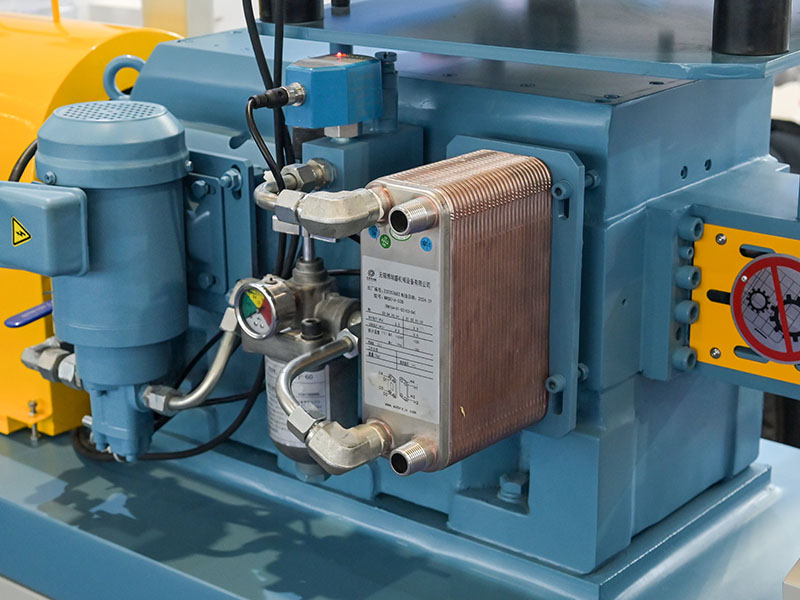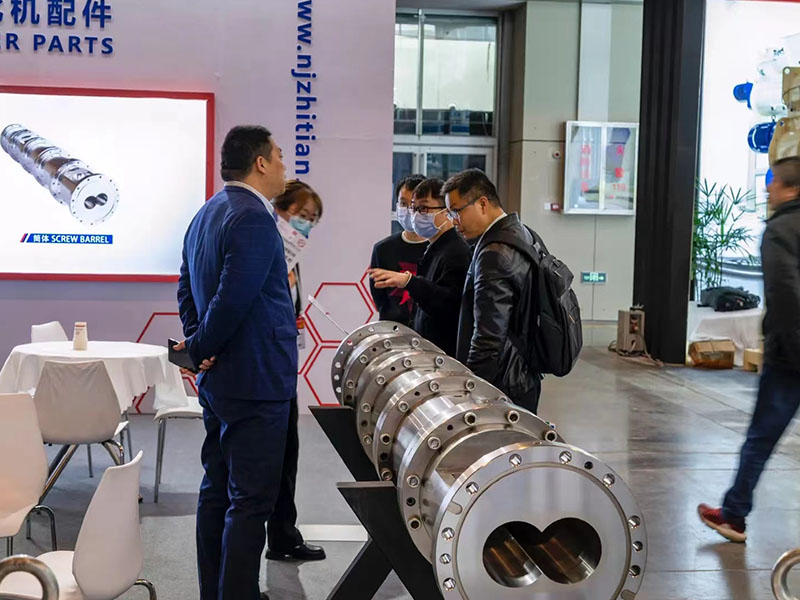Views: 0 Author: Site Editor Publish Time: 2025-03-28 Origin: Site








What exactly is an extruder gearbox, and why should you care? This crucial component plays a key role in industries like plastics, rubber, food, and metal extrusion. Without it, many manufacturing processes would grind to a halt.
In this post, we’ll dive into the importance of extruder gearboxes, how they work, and why understanding them can optimize your production processes.

An extruder gearbox is a crucial component in many industrial processes, particularly in extrusion machinery. It’s a transmission system designed to convert the high-speed rotation of a motor into the necessary torque for the extrusion process. This conversion ensures the extruder screw operates efficiently, driving materials through the die to create a finished product.
The gearbox works by reducing the motor’s speed while amplifying the torque. This speed reduction is essential because the motor’s high-speed rotation is too fast for the screw to function properly. The gearbox helps slow it down and increase the force, ensuring that the extruder screw moves the material through the extrusion die smoothly.
In addition to speed reduction, the gearbox also plays a key role in distributing the load evenly across the screw, preventing excessive wear and ensuring balanced operation. Some gearboxes even allow for changing the direction of the screw’s rotation, depending on the specific needs of the process.
The role of the extruder gearbox goes beyond just power transmission. It ensures smooth operations, reduces downtime, and helps optimize production, making it a vital part of any extrusion system.
An extruder gearbox is made up of several key components that work together to ensure smooth and efficient operation. Each part plays a specific role in transmitting power from the motor to the extruder screw.
Input and Output Shafts: These shafts connect the motor to the gearbox and transfer rotational energy. The input shaft receives power from the motor, while the output shaft drives the extruder screw.
Gears: Different types of gears are used in extruder gearboxes, including:
Helical gears: These provide smooth and quiet operation, ideal for handling high torque.
Bevel gears: Used to change the direction of the power flow, often in right-angle gearboxes.
Parallel shaft gears: Typically used in designs where the shafts run parallel to each other.
Thrust Bearings and Bearing Seals: These components support the load and reduce friction. Thrust bearings ensure that axial forces are absorbed, while bearing seals prevent contamination and ensure the longevity of the gearbox.
Each component must be durable and able to withstand high levels of stress, torque, and temperature. The gears must be heat-treated to ensure they can handle the intense conditions inside the gearbox. This heat treatment improves the gears' strength, resistance to wear, and ability to handle high torque without breaking down.
The bearing seals protect the internal components from dirt and moisture, which could cause damage over time. Without them, the gearbox would be prone to failures, leading to costly repairs and downtime.
In short, the durability of these components ensures that the gearbox operates efficiently and lasts longer, which is critical for any industrial application.

Extruder gearboxes come in various types, each designed to meet specific needs in different industrial applications. Understanding these types will help you choose the right one for your machinery.
Parallel Shaft Gearboxes: These gearboxes have shafts that run parallel to each other. They are commonly used in applications where space is limited and high torque is needed. Parallel shaft gearboxes are great for most standard extrusion processes.
Helical Gearboxes: Known for their smooth and quiet operation, helical gearboxes are ideal for handling high torque and heavy loads. These gears are perfect for extrusion processes that require efficiency and reduced vibration.
Bevel Gearboxes: Bevel gearboxes are used when the power needs to be transmitted at a 90-degree angle. These are typically found in setups where the gearbox needs to change the direction of power flow, making them versatile for various configurations.
Choosing the right extruder gearbox depends on several factors. You must consider the material type you're working with and the specific manufacturing process. For example, different materials may require different gear designs to ensure smooth material flow through the extruder.
Custom gearboxes, can provide tailored solutions. They offer flexibility in adjusting gear ratios and torque levels to suit your exact needs, making them a great choice for specialized applications.
When an extruder gearbox starts showing signs of trouble, you’ll need to decide whether to repair or replace it. This decision can impact both your budget and your production timeline.
How to Assess Whether to Repair or Replace:
If your gearbox is showing wear, it’s essential to assess the extent of the damage. Minor issues like lubrication problems or bearing wear can often be repaired. However, if the gears or shafts are severely damaged, replacement might be the best option.
Cost-Benefit Analysis of Repair vs. Replacement:
Repairs are generally more cost-effective if the damage is minor or localized. However, if your gearbox has multiple issues or is nearing the end of its life cycle, replacing it might save money in the long run. Consider the cost of downtime and how long a repaired gearbox will last compared to a new one.
When you choose to repair your gearbox, several services may be involved:
Common Repair Services:
Gear Manufacturing: Custom gears may need to be made if the originals are too worn.
Bearing Replacements: Bearings are often replaced to reduce friction and restore smooth operation.
Choosing a Specialized Repair Company:
It’s important to choose a company that specializes in extruder gearbox repairs. Look for experienced technicians who can diagnose and repair issues accurately. A trusted company will also help with preventive maintenance to keep your gearbox running longer.
Regular maintenance of your extruder gearbox is crucial for keeping it running smoothly and avoiding unexpected breakdowns. Neglecting maintenance can lead to costly repairs and production delays.
Reduces the Risk of Production Halts:
Regular maintenance helps prevent major failures that could stop production. Timely inspections catch issues early, minimizing downtime.
Improves Longevity of the Gearbox:
By keeping the gearbox in good working condition, maintenance extends its lifespan. This reduces the need for frequent repairs or replacements.
Lubrication and Sealing Systems:
Proper lubrication ensures smooth operation, while sealing systems protect the internal components from dirt and moisture. Both play a vital role in maintaining gearbox efficiency.
Regular Inspections:
Inspect the gearbox periodically for any signs of wear or damage. Early detection can save you from costly repairs later.
Keep Components Lubricated:
Ensure all moving parts are properly lubricated to reduce friction. This helps prevent wear and tear.
Proactive Measures:
Take steps like checking bearings and seals regularly. Keeping an eye on these components can help avoid unexpected breakdowns and extend the life of the gearbox.
Selecting the right extruder gearbox is critical to ensuring smooth operations in your production process. The right choice can boost efficiency and reduce downtime.
Gear Ratio and Torque Requirements:
Make sure the gearbox matches your process's gear ratio and torque needs. The gear ratio determines the speed reduction, and the torque must be high enough to drive the materials through the extruder.
Durability and Heat Resistance:
Gearboxes must withstand high temperatures and pressures. Choose a gearbox with high durability to ensure it can handle the stress of continuous use in demanding environments.
Cost and Manufacturer Reputation:
Consider the cost in relation to quality. Trusted manufacturers like Falk and Krauss Maffei are known for their reliable, long-lasting gearboxes. Their reputations speak to the quality and efficiency of their products.
Benefits of Choosing a Customized Gearbox:
For specialized applications, a customized gearbox can be a better fit. It allows you to tailor the gearbox to specific requirements, like unique torque or speed ratios. This flexibility ensures optimal performance and efficiency.
Extruder gearboxes are essential in a variety of industries, helping convert raw materials into finished products efficiently.
Plastics and Rubber Extrusion:
Extruder gearboxes play a vital role in shaping plastic and rubber products like pipes, sheets, and films.
Food Processing:
In the food industry, extruders are used to produce pasta, snacks, and even pet food. The gearbox ensures uniform shaping and efficient processing.
Metal Extrusion:
In metalworking, extruder gearboxes help form metal products like profiles and rods by applying high pressure.
Textile Industry:
For synthetic fibers, extruder gearboxes are used in melt spinning processes, turning raw materials into fibers for clothing and other textiles.
Efficiency in Transforming Raw Materials:
Extruder gearboxes help streamline production, turning raw materials into finished products quickly and consistently.
Cost Reduction Through Optimized Operations:
By ensuring smooth operation, gearboxes reduce energy consumption and minimize production delays, cutting costs in the long run.
Keeping your extruder gearbox in good condition is essential for ensuring smooth and efficient operations. Regular maintenance can prevent unexpected breakdowns and extend the life of your gearbox.
Preventative Maintenance Best Practices:
Perform regular inspections and cleaning. This includes checking for signs of wear, leaks, or unusual noise. Regularly replace lubricants to ensure smooth operation.
Monitoring Performance Indicators:
Keep an eye on performance indicators such as temperature and vibration levels. Unusual changes in these can be early signs of malfunction, allowing for timely repairs before the issue escalates.
Overlooking Small Issues:
Don’t ignore minor problems like slight leaks or unusual sounds. Small issues can quickly grow into bigger, more costly repairs.
Using Improper Lubricants or Neglecting Bearing Checks:
Using the wrong lubricant can cause excessive wear on the gearbox. Also, failing to check bearings regularly can lead to serious damage, affecting the entire system's efficiency.
Understanding extruder gearboxes is key to optimizing your manufacturing processes. From their function and components to types and maintenance, each element plays a crucial role.
To ensure your gearbox runs efficiently, regular maintenance and timely repairs are essential.
A: An extruder gearbox converts motor speed into the necessary torque for extrusion, playing a crucial role in shaping materials efficiently.
A: Key components include input and output shafts, gears (helical, bevel, parallel shaft), and thrust bearings with seals.
A: If damage is minor, repair may suffice. However, if gears or shafts are severely worn, replacement may be more cost-effective.
A: Look for unusual noises, vibrations, overheating, or decreased performance, which may indicate underlying issues.
A: No. The right gearbox depends on factors like gear ratio, torque requirements, material type, and specific process needs.